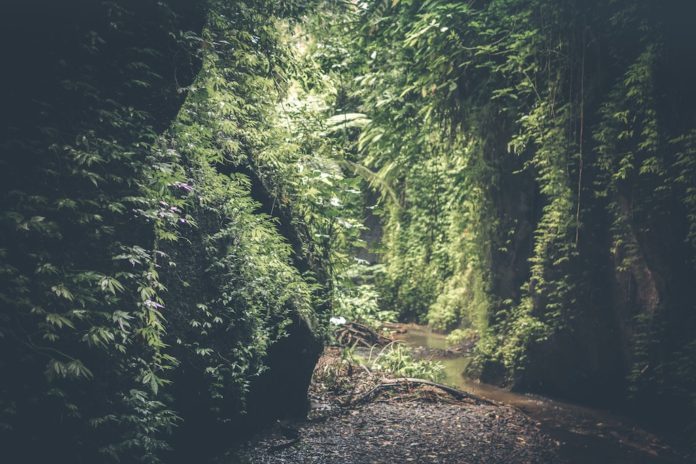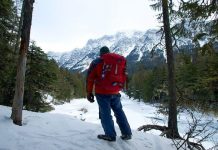Although the woods (or forest as city people prefer to call it) offer a bounty of natural resources, you must possess the survival skills necessary to utilize and harvest them. Actually, getting to the woods from either the suburbs or a city will be a miraculous feat in itself!
Before you continue to plan on grabbing your brand-spanking new bugout bag and heading to the woods, weigh the potentially deadly pros and cons very, very carefully!
Can People Survive in the Woods when the SHTF?
The short answer is yes. But, it is the long version of the response which truly matters. Becoming a mountain man or a mountain woman does not happen overnight or after several sessions of playing weekend warrior when your life doesn’t really depend upon finding your own food and water.
Bugging out to the woods after a doomsday disaster just might be the biggest prepper myth ever told. Just because you have been camping before and can find the nearest state or national forest without using GPS, does not mean you are prepared to ride out the apocalypse living in the woods.
Most of the folks who could really walk into the woods and survive already live at their prepper retreat. Should they be forced to evacuate their home and flee to the woods, it will be them, you will get the game and wild edibles the forest offers.
Bugging out to the forest means you can survive with little more than what you carry on your back – along with your wits, survival skills, and even a little bit of luck. If you have a horse with a pack-saddle, the opportunity to carry more supplies and a small tent, to your bugout location, exist but what will the horse eat over the long winter months?
Surviving in the woods, for the vast majority of folks, would be extremely risky and feasible only for a short amount of time, like a week or two. If forced to flee the suburbs or city, or even a rural town due to disease, fire, or the intrusion of a violent gang, the woods would provide safety, food, and water – but only temporarily.
If you cannot survive in the woods without the supplies in your bugout bag, you will not survive your time in the forest!
“I Think We’re Alone Now”
You and your loving family will not be the only ones rushing into the woods after a societal collapse. Thousands, possibly tens of thousands, of other Americans already have the same bugout to the woods idea. Tens of thousands more will suddenly get the idea when they are running from their homes in search of safety, food, water, and shelter also.
A tent will protect you from the elements, but it will be useless against bullets and silently creeping bad guys and gals with a knife. Almost all state and national parks have cabins, lodges, and other structures, such as bathhouses, utility buildings, and dining halls.
Any of those buildings would give you far more shelter than a tent – but only if you get there first and have the numbers and ammo necessary to hold them. The walls and windows in the park facilities won’t stop most rounds of ammunition either.
Danger could be lurking around every corner in the woods, just like it will be in the cities and suburbs. You will not just have to be on the lookout for wolves and bears, but for other desperate people who have an equal need for food, water, and shelter – and might not mind killing you and your family to get it.
“But; There’s Plenty of Food in the Woods”
Sure, deer and a plethora majestic wild animals roam freely about the woods… now. When untold thousands converge upon the woods seeking refuge from the societal collapse, the animal and fish population will evaporate quickly. The wild edibles, which exist but in much smaller quantities during the winter months, will be picked and consumed in rapid fashion as well.
Target practice at the range is not the same thing as hitting a moving target when your life depends on it. Watching YouTubes of experienced bushcrafters setting traps is NOT the same thing as being able to do it yourself. Even if you have practiced trapping skills, there is absolutely no guarantee you will place the trap in the right spot or that any wildlife is left in the area to be snared by your contraption.
If you need flash cards with color images to identify edible plants, weeds, herbs, nuts, berries, and mushrooms that exist in the woods – you will likely starve to death or perish due to poisoning.
Being prepared to bug out to the woods short-term if forced to leave your home or while traveling to a known place of safety is not necessarily a foolhardy idea – but it will still not be an easy or relatively danger-free endeavor.
No Vacancy
Do not fool yourself into thinking getting to the woods, even after leaving the crowded freeway and skyscrapers far behind will be easy. Both preppers and not preppers alike in rural areas will be waiting for you – and they will be heavily armed. Rural folks grew up hunting and sport shooting. They know, whether they actively prep for a doomsday disaster or not that if something bad does happen, hordes of fleeing suburban and city people will be rushing their way.
To reach ANY state or national park, you will have to cross a rural county line. Expect to be met with armed resistance and a firm order to turn around. Country folk will not tolerate the natural resources or safety of their bucolic small towns and villages to be threatened by strangers who chose to live in an unsustainable and dangerous area.
Just walking into the first wooded are you come to because you are exhausted or in danger will most likely place you in even greater peril. The woods you see, if not public land, are part of a rural citizen’s property. He or she will eventually find you and force you to get the heck off their land – one way or another.
The farmers and ranchers who own the woods you figure would be great to bugout to have been kicking trespassers off their land sometimes longer than you have been alive. They will not suddenly welcome strangers to use and take what is theirs after a TEOTWAWKI disaster happens.
How Far Away Is the Nearest Public Land?
After browsing a multitude of survival boards focused on the topic of bugging out in the woods, I discovered two very troubling issues. First, preppers have started an extensively high volume of threats devoted solely to the best state or national park to bug out to in any given region or state. The very thorough threads detailed all the many attributes of each park – even noting where the best natural shelter is located, exactly where to forage, the best spot to find deer, and a multitude of other site-specific tips.
Some of the posts have been read and commented upon THOUSANDS of times – presumably by folks in the same area who plan on bugging out to the woods. The competition for camping spot will be more fierce at the state and national parks on the list after the SHTF than it would be on a typical holiday weekend!
Secondly, the distance the bugging out to the woods folks would have to travel, likely on foot, to reach their “safe space” after the SHTF is at a minimum two hours! Many of the posters said the park they were bugging out to was up to six hours away! The travel times noted were of course, based on typical GPS travel times and did not take into account stand-still traffic, blocked roadways, or going it on foot.
The distance issue is a double-edged sword for preppers who know they will have to bugout after a disaster. Survival experts recommend being at least 100 miles or two hours away from a metropolitan area. They are right – and why most preppers do not live in either the cities or suburbs.
Preppers rushing to leave the city know they need to be as far away as possible, but reaching their destination, especially on foot, will be filled with incredibly dangerous obstacles.
Kudos for the city dwellers refusing to stick their heads in the sand and ignore the need to prep for a mega disaster. But, the good-intentions of these misguided folks will not protect them from complete failure – and sadly, even a predictable death not long after they flee their homes.
Bugging Out to the Woods Alternatives
Instead of following thousands of people out of the city and straight into the woods, find a patch of land to call your own – or kind of your own, at least. Not everyone can afford to go buy even a few acres of land, at least not on their own.
If the like-minded strangers sharing bugout tips about their favorite state and national parks online banded together, they could buy at least several acres to run to after the SHTF. Networking with complete strangers doesn’t come without risk and should begin with backgrounds check and meeting in public places. Preppers who bug out to the woods will be coming with hundreds to thousands of strangers anyway, getting to know others in a similar position with shared goals would not only mitigate the risks associated with bugging out to the woods, but provide the numbers necessary to work the land/hunt/fish and protect the camp.
Entering into an annual lease at a campground; preferably a private one, would offer a home base to bugout to after the SHTF. You will still be among strangers and not completely secluded, but a motor home stocked with supplies could be parked in the space and awaiting your arrival. Getting other friends and loved ones to lease a camping spot at the same campground would also be beneficial to your (and their) overall survival.
When land is purchased by a group or a campground space is leased by you alone, you have the ability to go their frequently and learn the terrain, animal habits, where to forage, and even plant some perennial seeds in food forest style to help increase the available post-disaster food supply. You could spend a weekend at the leased or purchased space to practice your preps and enhancing your level or personal physical fitness.
Leasing a quarter acre of land from a rural resident is also another bugging out to the woods alternative. The extra money in the pocket for the resident and a safe place for you to run to after disaster strikes is a win-win. Many rural folks lease hunting space or primitive camping space on underutilized portions of their land. When you explain to the property owner that you are a prepper and want to park a camper or motor home on the spot; he or she won’t likely stare at you like you have two heads.
Many rural citizens are preppers or live a homesteading lifestyle and will understand your need to escape the suburbs or city when the SHTF. If you’re lucky, you might just stumble across a seasoned prepper who will help you enhance your survival skills – and even offer you the chance to chop wood for them as part of your off-grid training!
If You’re Still Gonna do it, Make a Real Bugout to the Woods Plan
If you live in a city and absolutely have no other location to flee to when the SHTF, or need a bugging in the backup plan, and bugging out to the woods is your ONLY option, a detailed and in-depth plan must be developed, practiced, and perfected.
-
Transportation
Getting to the woods on foot should only be a last resort. Not only will you be able to carry a minuscule amount of supplies, the going will be both incredibly slow and dangerous. Survival Sullivan’s bugout vehicle report details the pros and cons of all the best options for SHTF transportation.
- Horse – Riding a horse speeds up the travel time and increase supply hauling capabilities; but poses possible problems as well. If surviving in the woods is only a short-term solution because you are traveling on to safety or plan on returning to your home after whatever threat forced you to flee in the first place is eliminated, a horse will be a fine option.
- Vehicle – Traveling in a car will get you inside a national or state park, or any wooded area far more quickly only if the SHTF scenario did not involve a solar flare or EMP AND if roadways are not too clogged to traverse or ripe with violent carjackers. An EMP-proof vehicle should be the first and most important item on a bugout to the woods survival plan and preparedness budget.
- ATV – A four-wheeler or similar all-terrain vehicle will be able to maneuver or clogged roads far more easily than any vehicle after the SHTF. A trailer attached to a hitch on the back of the ATV will allow you to carry more supplies or loved ones. Cargo racks on the back and front of the 4-wheeler also allow space for storing essential supplies, like gas and a spare tire. A standard cargo trailer which can be towed behind an ATV or a similarly sized vehicle is about 48” by 30”. When stacked to the top, you will have about 25-square-feet of storage space. Cover the trailer with a tarp to both protect the gear inside and to use to make a shelter after reaching the woods.
- Tractor – Either a farm tractor or garden riding lawnmower will move you along faster than your own two feet. A trailer hooked onto the tractor offers extra space for supplies and carrying or collecting loved ones. Tractors will not get you very far into the woods, but they will be able to maneuver around abandoned vehicles cluttering the highway and stuck in a panicked traffic jam.
- Motor Home – A house on wheels will not move through jammed roadways, but it would give your far more shelter and supply-carrying capabilities than any other bugout mode of transportation option. The motor home also will not get your deep into the woods, but will get you into a less densely populated area – unless; again; the SHTF disaster was an EMP or solar flare.
- Bike – A bicycle, street bike, or dirt bike, will not provide as much safety or supply space as either a vehicle or a motor home; but will speed up the commute to the woods. A motorcycle bugout vehicle should be stored in a Faraday cage-style shed or garage to enhance the chances it will get you where you are going in case an EMP or solar flare sparked the apocalyptic event.
-
Practice
Surviving in the woods will require an abundance of physical strength and endurance. People used to only walking on level concrete sidewalks for the bulk of their life will be at a distinct disadvantage. Jogging around a city park trail or the occasional camping trip simply will not suffice.
- Put on your bugout bag and walk the same distance it would take for you to leave your home or place of work, and get to the woods. The time and physical ability it takes to do this, even in broad daylight, on decent level ground, like a bike path, and in nice weather, will likely be a sobering reality check.
- Go the woods where you plan on bugging out, with the bugout bag on your back once again, and hike at least three miles. This will give a clear idea of the physical strain hiking deep into the woods will take on your body. Do this SHTF conditioning drill on an empty stomach and with just a single bottle of water to replicate the scenario you will likely find yourself in when fleeing your home a lot more accurately.
- Go camping, real primitive camping – do not take a tent. If you cannot make a natural shelter out of finding materials before nightfall, you must repeat this bugging out in the woods drill until you can do so even when extremely hungry, tired, and thirsty. Just because you are planning on sleeping in your bug out vehicle or motor home does not mean you will actually be afforded such a luxury after the SHTF.
- Choose two survival skills to learn or perfect during your daily outings or weekends spent practicing your bugout to the woods plan. Some skills to practice while in the woods include: how to start a fire without matches, particularly during inclement weather, how to build a proper fire and keep it going – without spreading, how to tie knots needed to make a shelter from found items, how to build a shelter from found items, orienteering, and identifying animal tracks.
- Practicing your bowhunting and shooting skills at a state or national park will not likely be possible. Find a designated public hunting spot or lease hunting rights on private land to hone your hunting skills. Taking tactical training from a shooting range or professional who specializes in such training is equally essential. You must prepare yourself both physically and mentally for the very real possibility that a human being will one day be looking down the barrel of your gun. Defending yourself and what belongs to you will be the only thing that matters when threatened after a societal collapse.
- Perfecting your fishing and swimming skills to prepare for bugging out in the woods should be added to the weekend (weeklong; if possible) prepper training sessions. Getting away from danger by taking to a waterway might one day be your only option – especially during a wildfire.
- Outdoor cooking is a lot of fun when camping, but getting meat to cook at a safe temperature will take a little practice. Burning a single bite of the food you worked so hard to shoot or catch would be a tragedy. Undercooked meat could cause you to become extremely ill, and you can’t call 911 after the SHTF.
Final Words
Bugging out to the woods should be a last ditch effort to survive and NOT your bugout plan. When the SHTF you want to go where people aren’t where they have converged after hours or days of panic. If bugging out to the woods is your only option at the moment; go into it with open hours and spend as much time as you can spare truly preparing to live in the woods – while you work on a better bugout location plan.














![How to Survive a Street Fight [Videos Inside]](https://www.dailypreppernews.com/wp-content/uploads/2019/06/unnamed-file-1-696x522-100x70.jpg)






